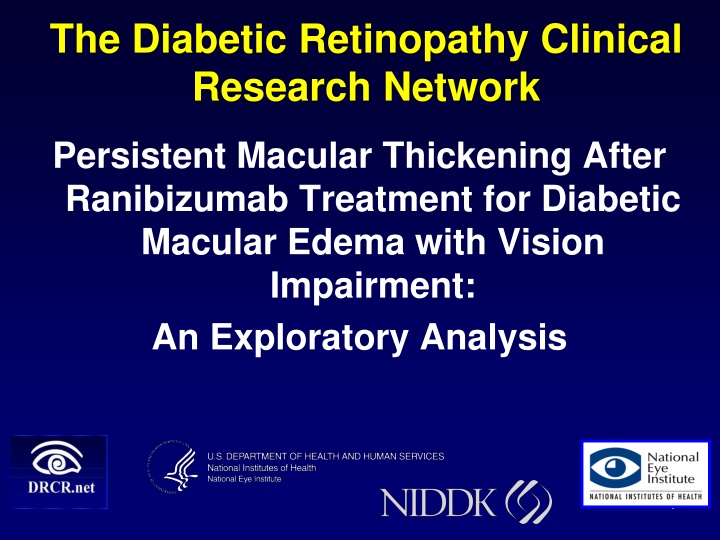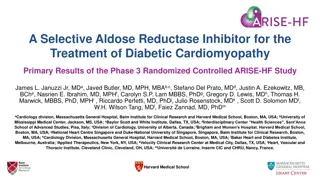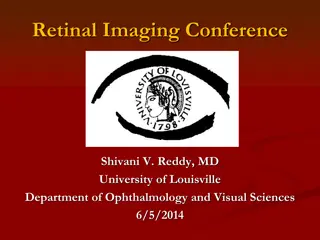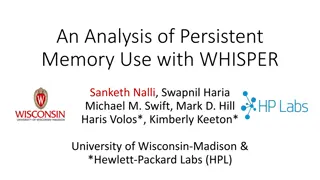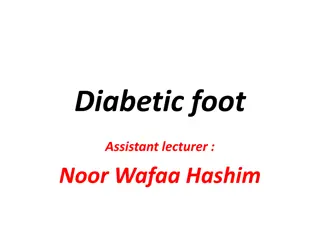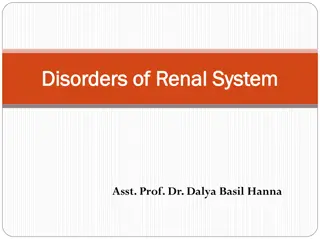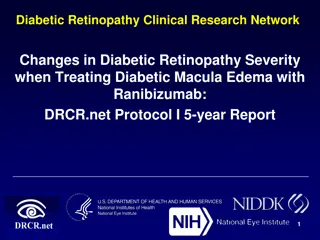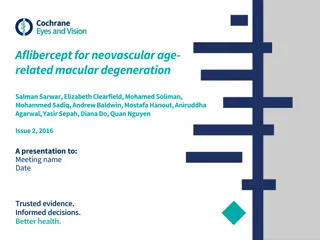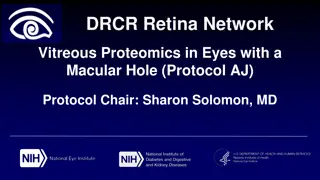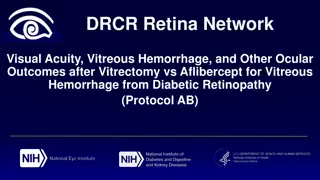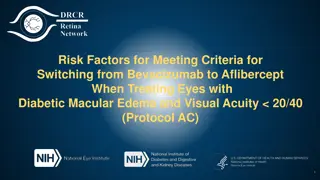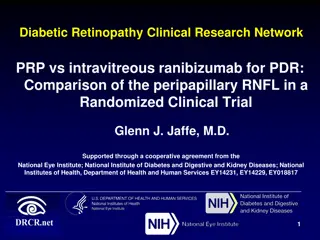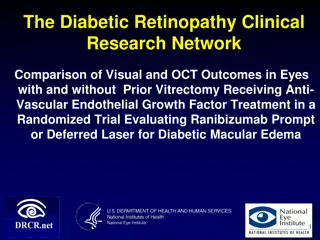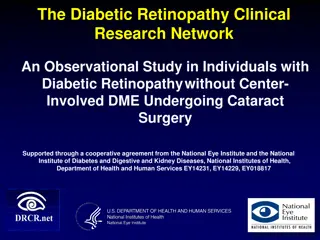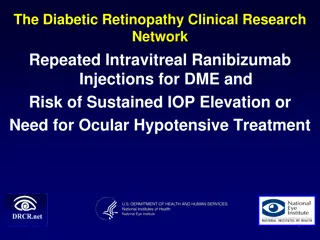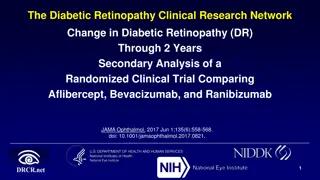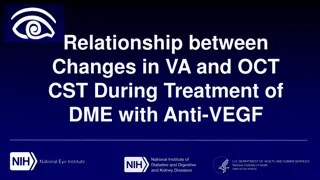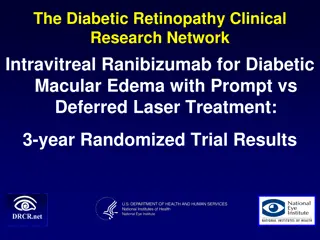Persistent Macular Thickening After Ranibizumab Treatment for Diabetic Macular Edema
Multiple randomized trials have shown visual acuity benefits of anti-VEGF therapy in diabetic macular edema (DME) cases. However, some eyes may exhibit persistent macular edema despite treatment with ranibizumab. A post-hoc analysis was conducted to assess outcomes of eyes with DME that persisted after initiating ranibizumab treatment. The analysis focused on the Protocol I visits and treatments, particularly in the subgroup of participants with persistent DME.
Download Presentation

Please find below an Image/Link to download the presentation.
The content on the website is provided AS IS for your information and personal use only. It may not be sold, licensed, or shared on other websites without obtaining consent from the author.If you encounter any issues during the download, it is possible that the publisher has removed the file from their server.
You are allowed to download the files provided on this website for personal or commercial use, subject to the condition that they are used lawfully. All files are the property of their respective owners.
The content on the website is provided AS IS for your information and personal use only. It may not be sold, licensed, or shared on other websites without obtaining consent from the author.
E N D
Presentation Transcript
The Diabetic Retinopathy Clinical Research Network Persistent Macular Thickening After Ranibizumab Treatment for Diabetic Macular Edema with Vision Impairment: An Exploratory Analysis 1
Background Multiple relatively large randomized clinical trials have shown visual acuity benefits of anti-VEGF therapy in eyes with center-involved DME: DRCR.net Protocol I BOLT RIDE and RISE RESTORE VIVID and VISTA 2
Background However, many eyes may have persistent edema involving the central subfield on OCT or recurrence of such edema 1 or 2 years after initiating treatment Data from DRCR.net Protocol I Trial Ranibizumab with Prompt or Deferred Laser 1 Year N = 338 49% 2 Year N = 317 41% CSF 250 m 27% 22% CSF 300 m CSF 250 m and VA letter score improvement < 10 from baseline 28% 25% CSF = OCT Central Subfield (Zeiss Stratus) 3
Background Treatment protocols allowed the treating ophthalmologists to observe eyes with stable DME without additional anti-VEGF treatment despite the absence of complete resolution of DME. These finding suggest that clinicians managing patients with ranibizumab may have many patients with persistent DME despite months or repeat injections of anti-VEGF 4
Objective Post-hoc, exploratory analysis from a DRCR.net randomized trial to assess subsequent outcomes (VA and OCT) of eyes with DME which persisted 24 weeks after initiating ranibizumab. 5
Protocol I Visits and Treatments Current analysis looking only at the 2 ranibizumab arms Original trial eligibility: CSF >250 m and VA 20/32 to 20/320 Visits every 4 weeks through 52-week and every 4, 8, or 16 weeks thereafter, depending on the clinical course and treatments received. Injections every 4 weeks for the initial 12 weeks and through 20 weeks if DME persisted. Thereafter, injections repeated every 4 weeks if improvement but vision remained worse than 20/20 with CST 250 m. Otherwise, re-injection at investigator discretion. Focal/grid laser at baseline in ranibizumab+prompt laser group, and >=24 weeks if persistent DME in the ranibizumab+deferred laser group. Additional laser every 4 months if edema persisted . Other treatments not considered unless failure or futility. 6
Analysis Cohort ( Persistent DME Cohort ) Subgroup of participants from DRCR.net Laser-Ranibizumab-Triamcinolone randomized clinical trial meeting the following: Persistent DME through 24-week visit (Stratus OCT CSF 250 m at all visits through 24- week visit) At least 4 intravitreal ranibizumab injections before 24-week visit 2 missed visits during the 1st year 7
Analysis Cohort ( Persistent DME Cohort ) Ranibizumab + Prompt or Deferred Laser Randomized 361 With 4+ injections before 24 weeks and 2 missed visit during 1st year With persistent central- involved DME at all visits thru week-24 visit 296 (82% of 361) 117 (40% of 296) 8
Main Outcome of Interest Chronicpersistent DME Failure to achieve Stratus OCT CSF <250 m and 10% reduction relative to the 24-week visit on at least 2 consecutive 4-week visits after the 24- week visit 9
Statistical Methods Cumulative probabilities of chronic persistent DME at each study visit from 28-week up to the 3-year visit were calculated using life-table method. Censoring Non-protocol treatment (there were 4 cases) <4 visits between annual visits 10
Baseline Features stratified by whether in Persistent DME Cohort Persistent DME thru week 24 Yes N = 117 39% No N = 179 44% Women - % Median Age (yrs) 64 63 White - % 80% 70% Type 2 Diabetes - % 93% 90% Median HbA1c (%) 7.2 7.5 Prior Trt for DME - % 64% 66% *only includes eyes with 4+ injections before 24 weeks and 2 missed visit during 1st year 11
Visual Acuity stratified by whether in Persistent DME Cohort Persistent DME thru week 24 Yes No Median - Letter Score N = 117 N = 179 Baseline 65 (20/50) 65 (20/50) 24-week visit 73 (20/40) 74 (20/32) Change from baseline to 24-week visit +7 +8 *Includes only eyes with 4+ injections before 24 weeks and 2 missed visit during 1st year 12
OCT Central Subfield stratified by whether in Persistent DME Cohort Persistent DME thru week 24 Yes No Median - m N = 117 N = 179 Baseline 422 365 Week 24 309 227 Change from baseline to 24 week -99 -128 *Includes only eyes with 4+ injections before 24 weeks and 2 missed visit during 1st year 13
Cumulative Number of Injections through 3 Years in Persistent DME Cohort Chronic Persistent DME* Yes No Median week 24 to prior to 1 year 5 5 week 52 to prior to 2 year week 104 to prior to 3 year prior to 1 year prior to 2 year 5 3 2 2 11 13 10 15 prior to 3 year 17 16 **By 1-, 2-, or 3-year visit, for those completing 1-, 2-, or 3-year visit respectively 14
Chronic Persistent DME Over Time Persistent DME Cohort 40% by 3 years 99%CI: (27%, 52%) 15
Visual Acuity at 1 Year in Persistent DME Cohort Chronic Persistent DME through 1 Year Yes N = 95 No N = 22 Median VA (~Snellen Equivalent) 75 (20/32) 75 (20/32) Median Change from Baseline - Letter Score 10 Letter Gain from Baseline - % +8 +8 44% 46% 10 Letter Loss from Baseline - % 4% 0 16
Visual Acuity at 2 Years in Persistent DME Cohort Chronic Persistent DME through 2 Years Yes N = 61 No N = 48 Median VA (~Snellen Equivalent) 74 (20/32) 76 (20/32) Median Change from Baseline - Letter Score 10 Letter Gain from Baseline - % +8 +11 43% 58% 10 Letter Loss from Baseline - % 8% 2% 17
Visual Acuity at 3 Years in Persistent DME Cohort Chronic Persistent DME through 3 Years Yes N = 40 No N = 60 Median VA (~Snellen Equivalent) 76 (20/32) 79 (20/25) Median Change from Baseline - Letter Score 10 Letter Gain from Baseline - % +5 +12 43% 60% 10 Letter Loss from Baseline - % 13% 3% 18
Median Change in Visual Acuity from Baseline in Persistent DME Cohort 15 Median Change in Visual Acuity 14 13 from Baseline (letter score) N = 60 12 N = 48 With Chronic PersistentDME 11 10 9 N = 61 N = 22 N = 95 8 7 Without Chronic PersistentDME 6 N = 40 5 4 3 2 1 0 1 Year 2 Year 3 Year 19
Median Visual Acuity in Persistent DME Cohort 85 N = 60 80 N = 48 N = 40 20/32 20/25 N = 95 N = 22 N = 61 20/3220/32 Median Visual Acuity (letter score) 75 20/32 20/32 70 With Chronic Persistent DME 65 60 55 50 45 Without Chronic Persistent DME 40 35 30 25 20 15 10 5 0 1 Year 2 Year 3 Year 20
Visual Acuity Improvement of 10 Letters from Baseline in Persistent DME Cohort 100 90 % VA Gain 10+ Letters 80 With Chronic Persistent DME 70 N = 60 N = 48 60 50 N = 22 N = 95 N = 61 N = 40 Without Chronic Persistent DME 40 30 20 10 0 1 Year 2 Year 3 Year 21
Visual Acuity Worsening of 10 Letters from Baseline in Persistent DME Cohort 100 90 % Lose 10+ Letters 80 With Chronic Persistent DME 70 60 50 Without Chronic Persistent DME 40 30 20 N = 40 N = 61 10 N = 95 N = 60 N = 22 N = 48 0 1 Year 2 Year 3 Year 22
Summary These data suggest less than half of eyes treated for DME with ranibizumab have persistent DME through 24 weeks after initiating treatment Approximately 40% of these eyes continue to have chronic persistent DME through 3 years with continued anti-VEGF treatment and laser as given in this protocol Probability of chronic persistent DME decreased over time - 81%, 56%, and 40% by year 1, 2, and 3 respectively Better visual acuity outcomes for eyes without chronic persistent DME, especially over a prolonged period. But regardless (with or without chronic persistent DME through 3 years), vision in eyes that had persistent DME through 24 weeks improved on average from baseline to 3 years A substantial number gained at least 10 letters (43% and 60%, respectively) Only a small number of eyes lost at least 10 letters (13% and 3%, respectively) 23
Limitations It is unknown how the treatment decisions that were made at investigator discretion >24 weeks affected the visual acuity and OCT outcomes reported. It is unknown what would have happened to these eyes had treatment been discontinued at 24 weeks for those with persistent edema, including how many would have had resolution of DME over time just with observation over time. The effect of potential bias from censoring (potentially higher risk) participants is unknown. Analyses were not performed on data available beyond 3 years due to small numbers in the subgroup with persistent edema. Analyses did not further sub-divide resolved cases into those that maintained absence of DME vs. those that had recurrence of central-involved DME due to numerous scenarios of resolution and recurrence at various intervals over time. 24
Limitations Although it would be interesting to compare the visual acuity results of the cohort that was the focus of this analysis with the remaining 179 eyes randomly assigned to ranibizumab that did not have persistent DME through 24 weeks, such a comparison would be difficult to evaluate. The persistent DME cohort identified for this analysis had more severe DME reflected in thicker CST at study entry and the follow-up algorithm was based, in part, on CST changes which may be affected by baseline CST. Thus, it becomes impossible to parse out the reasons for different outcomes of these cohorts. The literature does not contain a widely accepted definition for persistent DME or chronic persistent DME in the context of anti-VEGF therapy. Had a different definition been used for either persistent DME or chronic persistent DME, the results of these analyses may have been different. 25
Conclusions These findings suggest that when ophthalmologists followed the retreatment and visit regimen used in this study, continued resolution of central-involved edema occurred in many eyes that had not resolved by 24 weeks Longer-term visual acuity outcomes appear to be better among eyes without chronic persistent DME. Nevertheless, substantial ( 2 line) loss of visual acuity is uncommon at three years, even when central- involved DME persists. This current treatment strategy should be considered while other studies for alternatives to treat chronic persistent DME are pursued. 26
